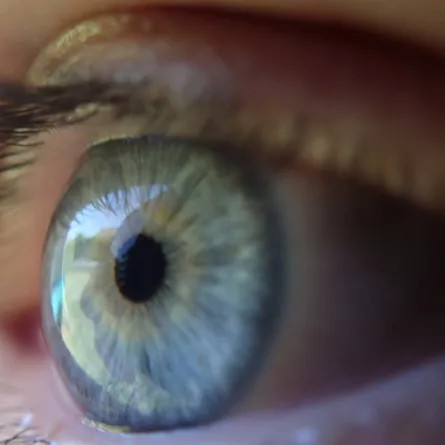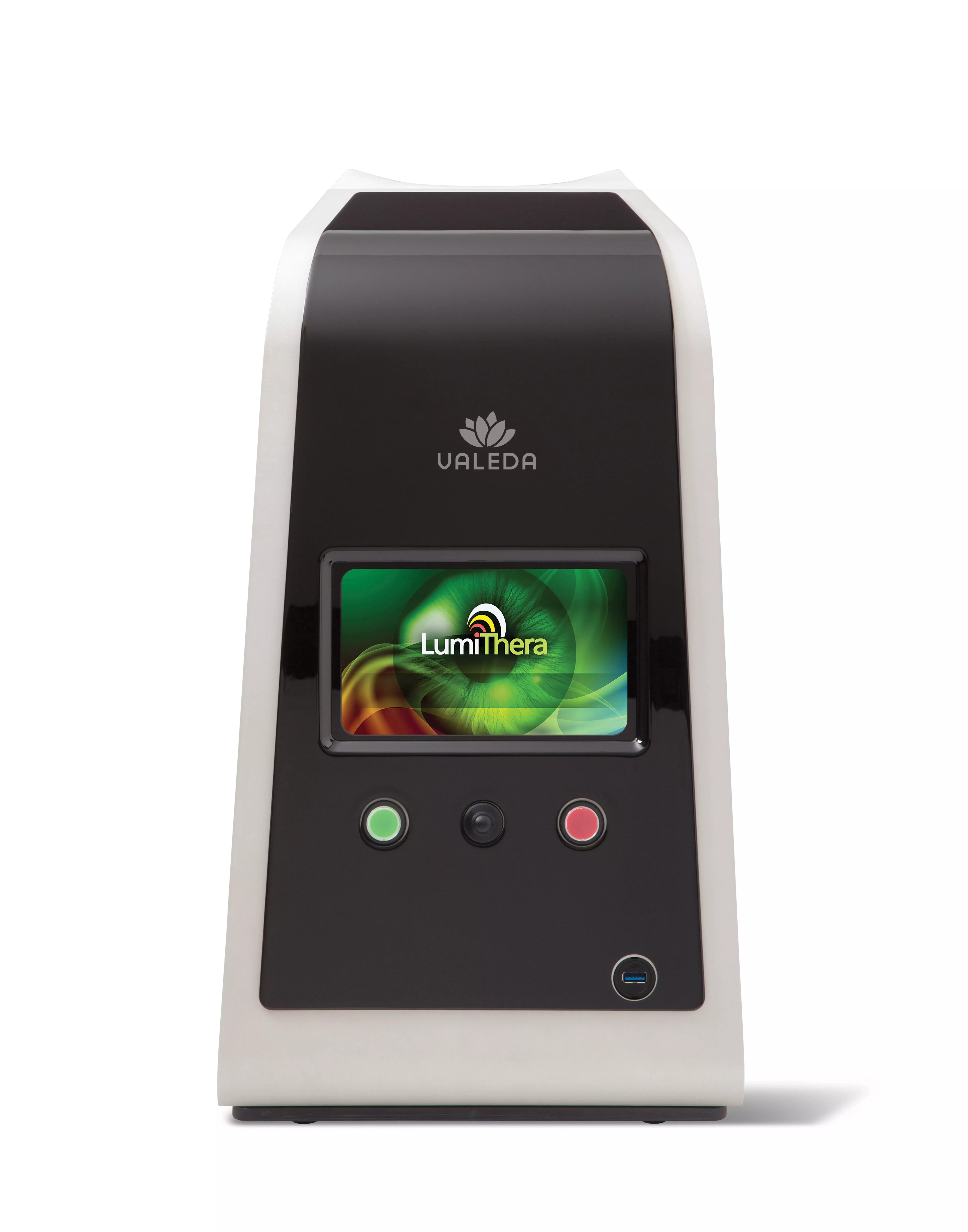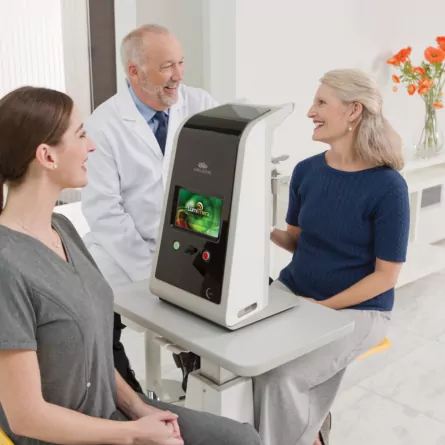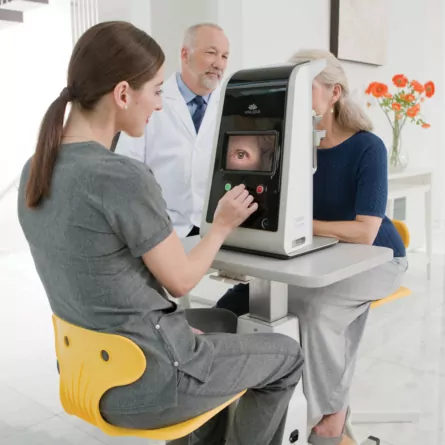
Request a Callback

What Is Valeda Light Therapy?
Until now, the extent of addressing Dry Age-Related Macular Degeneration (Dry AMD) has primarily revolved around dietary supplements and lifestyle adjustments. At Optegra we’re excited to offer our patients the latest and first ever approved treatment by the FDA for patients with Dry AMD.
The Valeda Light Delivery System (LDS) offers a safe, non-invasive, and painless therapy, treatment cycles are repeated, ideally three times a year to maintain the effect.

What is Dry Age-Related Macular Degeneration (AMD)?
Dry Age-Related Macular Degeneration (AMD) is a common eye condition associated with ageing, characterised by the deterioration of the macula—a part of the retina responsible for central vision. In this form of AMD, the cells in the macula gradually break down, leading to a progressive loss of central vision over time. In fact, Dry Age-Related Macular Degeneration is the leading cause of central vision loss in people aged 50 and above, impacting over 700,000 people in the UK.

How Dry AMD Gradually Leads to Deteriorating Vision
Patients suffering from AMD tend to notice the following:
Gradual Progressive Loss of Vision: As AMD advances, the clarity of your central focus may diminish, resulting in blurred, distorted, or lost vision. This deterioration significantly affects activities like driving, recognising faces, reading, watching TV, and various aspects of daily life.
Difficulty Reading, Watching TV, and Driving: The ability to discern textures and contrasts diminishes, making it challenging to navigate uneven walkways and stairs, thereby increasing the risk of falls.
Impaired Depth Perception: Difficulty in accurately judging distances poses a risk of accidents and falls.
Sensitivity to Changing Light Levels: Struggling to adapt to varying light conditions and increased sensitivity to glare become noticeable challenges.
Increased Dependence on Brighter Light: Everyday tasks such as reading, cooking, and other activities may require higher light levels due to diminishing visual acuity.
Before the advent of Valeda Light Therapy, treatment options for Dry AMD had been severely limited, relying on early detection and preventative measures to mitigate its impact on vision.

How Does Valeda Light Therapy Work?
Light therapy uses different wavelengths of LED light to target cells and stimulate their activity to slow down the degenerative process.
Valeda operates by stimulating energy production within the eye’s cells, enhancing their capability to fulfil their roles effectively. The promotion of cellular health is crucial for maintaining optimal eye health. Patients will typically have a treatment cycle consisting of nine treatments spread over three to four week period. Treatment cycles are repeated, ideally three times a year to maintain the effect.

Who is Suitable For The Valeda Light Therapy System?
Valeda is prescribed for addressing Dry Age-Related Macular Degeneration (AMD). Individuals undergoing treatment should have received a diagnosis of Dry AMD from an eye care professional. Typically, people aged 50 and above are affected by Dry Age-Related Macular Degeneration and would be suitable for the Valeda Light Therapy System.
If you are interested in learning more about Valeda, you can book a free consultation with one of our experts. We will engage in a detailed discussion about your diagnosis and collaborate with you on a personalised treatment plan. At Optegra we ensure you have detailed tests with all the latest retinal scanning technology and a specialist consultant review to confirm you would benefit from treatment.

Is Anyone Unsuitable For Valeda Treatment?
As a safety measure, individuals who have not undergone testing or have known light exposure reactions should refrain from receiving treatment with Valeda. Similarly, those with a history of light-activated central nervous system disorders, such as epilepsy or where light exposure triggers migraine, are advised against using Valeda.
Additionally, individuals should avoid treatment within 30 days of using any photosensitising medications, including topicals and injectables, without first consulting their eye care professional.

The Valeda Treatment Preparation & Process
- If you wear glasses or contact lenses, you will need to remove them before the Valeda treatment.
- Unlike most laser and cataract eye surgeries, no dilation of the eyes is required for the Valeda treatment.
- The treatment, guided by an expert administrator, involves a step-by-step process, typically taking less than 5 minutes. You will be comfortably seated in front of the Valeda Light Delivery System for the procedure.
- Bright lights may generate an afterimage post-treatment, a phenomenon recognised as photostress, wherein cells responsible for perceiving a particular colour experience fatigue. Recovery from photostress may require a few minutes after the treatment. Although this effect may manifest immediately following the session, complete recovery typically occurs within a couple of minutes. Subsequently, you can readily engage in regular activities without any hindrance following treatment.
- Treatment for both eyes is completed within a time frame of less than 10 minutes.
- In a recent clinical study, patients received a maximum of three treatments per week and no more than one treatment within a 24-hour period.
- If a treatment is missed, it is advised to make up the session within the 3–4-week treatment series period.

The Results of Valeda & Potential Side Effects
Results
Valeda therapy enhances comprehensive visual function, demonstrating advancements in both eyechart scores and detailed vision. Photographic imaging reveals positive changes in eye scans, particularly in the reduction or improvement of drusen, which are protein deposits commonly observed in diseased eyes.
Clinical trials have demonstrated improved visual function with a recommended treatment protocol of 3 sessions per week for 3-4 weeks for patients with Dry AMD.
Side Effects
Photobiomodulation (PBM) constitutes a low-level light therapy that facilitates enhanced cellular function. Demonstrating a positive safety profile, PBM has been employed in various diseases and disorders for decades.
Clinical trials involving Dry AMD patients have indicated the safety of light therapy, with Valeda specifically engineered to ensure eye safety. Notably, previous studies involving the Valeda treatment have reported no treatment-related side effects, underscoring its safety and efficacy.
Dry AMD Costs
Our Dry AMD package includes your consultation and treatment so the price you see is the price you’ll pay, with no hidden extras. The cost is the same whether it is for one or both eyes but is not available using private medical insurance.
- First treatment cycle will cost £1,645 (9 sessions)
- Any following treatment cycle will cost £1,495
At Optegra we’re excited to offer patients the latest breakthrough in Dry AMD treatment.Dr Sajjad Mahmood
Consultant Ophthalmic Surgeon
